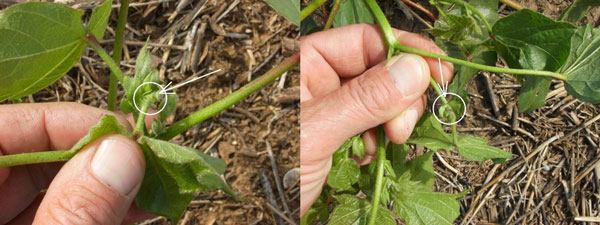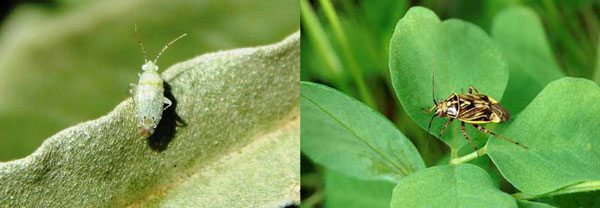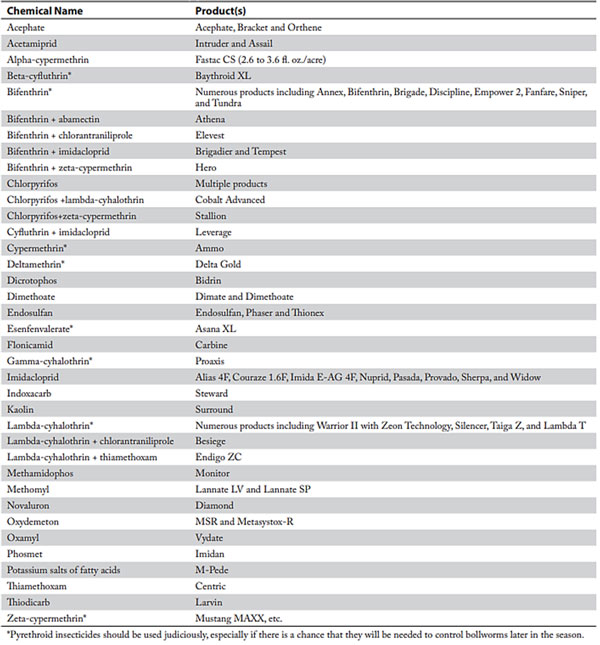As cotton in Kansas begins setting squares, our attention shifts from monitoring thrips to monitoring cotton fleahoppers and lygus bugs (also known as tarnished plant bugs). Cotton should be scouted for these insects from the six-leaf stage until square production stops. Feeding damage from fleahoppers and lygus bugs is very similar, and both cause squares to drop (Figure 1).

Figure 1. Missing squares as the result of cotton fleahopper/lygus bug damage. Photos courtesy of Rex Friesen.
Scouting for cotton fleahoppers and lygus bugs
Cotton fleahoppers are a 1/8-inch long and yellowish-green insect with an elongated, oval-shaped body that is slightly flattened over the top (Figure 2). Adult fleahoppers have a few dark spots near the rear of the upper surface of the back. Fleahopper nymphs are small and white to light green. Begin scouting for fleahoppers when cotton reaches the six-leaf stage. Alternate hosts are croton and silverleaf nightshade, so damaging infestations are more likely where these weeds are abundant. If small squares (immature flower buds) turn brown and drop to the ground (Figure 1), the damage may be caused by fleahoppers. If more than 10 to 20% of small squares are lost in pre-bloom cotton, plants should be examined for the presence of fleahoppers.

Figure 2. Adult cotton fleahopper (left) and lygus bug (right). Photo courtesy of J.P. Michaud.
Scouting for cotton fleahoppers may be difficult because adults jump from plants if they see a shadow. During the first three weeks of squaring, the economic threshold is approximately 25 to 40 fleahoppers per 100 terminals with 10 to 15% blasted squares. Other sampling techniques involve the use of a drop cloth or sweep net. When sampling with a drop cloth, place the drop cloth between the rows and shake plants vigorously over the cloth. Treatment should be considered when counts range between one and three fleahoppers per foot of row. With a sweep net, the threshold ranges between 1 and 1.5 fleahoppers per 10 sweeps. These insects attack the most immature squares, so if 75% or more squares are retained, there is probably no significant fleahopper population present.
Lygus bugs may present another problem for Kansas cotton growers especially where cotton is close to alfalfa. Lygus bug adults are approximately 1/4-inch long and 1/8-inch wide with flat, yellowish-brown bodies and reddish-brown and black mottling (Figure 2). Adults have a conspicuous yellow Y-shaped marking. Watch for lygus bugs to move into cotton fields following alfalfa cuttings, which occur at about the same time as fleahoppers. Alfalfa can be a significant reservoir for lygus bugs. So far this year, lygus bug populations in western Kansas alfalfa fields are notably high, so this is a pest that needs to be more alert during this cotton growing season. According to some references, one lygus bug equals about three fleahoppers.
Control options for fleahoppers and lygus bugs
In most cases, the limited potential for late-developing squares to enhance cotton lint and seed yields, coupled with the chance of unleashing bollworms by killing beneficial insects, offset the advantages of protecting late squares if a late-season fleahopper or lygus bug infestation occurs. Where significant numbers of fleahoppers or lygus are found, use insecticides that have the least effect on beneficial arthropods because they are important for the suppression of bollworms later in the season. Use lower rates and do not worry if you do not achieve 100% control. Many insecticides listed for fleahoppers are labeled for lygus bugs (Table 1).
Table 1. Insecticides labeled for fleahopper and lygus bug control in cotton.

Other mid-season insect considerations for cotton
The bollworm (corn earworm or sorghum headworm) is a serious pest across much of the US cotton belt. However, damage has been limited in Kansas even when significant infestations have developed in corn and grain sorghum. Growers should watch for developing infestations during fruiting and boll development. Bollworm management is based on scouting for eggs or small larvae. Treatment is recommended in cotton that does not express Bt traits when ten eggs or five small worms per 100 plants are present during early bloom in late July and early August. The use of Bt cotton (Bollgard II® and Widestrike™) in Kansas is common. However, bollworm resistance to currently used Bt traits has been documented. It may take up to five days from ingestion to death when susceptible bollworm feed on Bt cotton. Bt cotton should be scouted every 2 to 3 days to determine if young bollworms are being controlled. Consider spraying if fruit and boll damage are excessive, as indicated by ten small worms (1/4- to 3/8-inch long) per 100 plants or six small worms in 100 flowers.
For more information on insect pest management in cotton, see the 2024 Cotton Insect Pest Management bulletin available from the KSRE Bookstore: https://bookstore.ksre.ksu.edu/item/cotton-insect-pest-management-2024_MF2674
The use of trade names is for clarity to readers and does not imply endorsement of a particular product, nor does exclusion imply non-approval. Always consult the insecticide label for the most current use requirements.
Logan Simon, Southwest Area Agronomist – Garden City
lsimon@ksu.edu
Anthony Zukoff, Extension Entomologist – Garden City
azukoff@ksu.edu